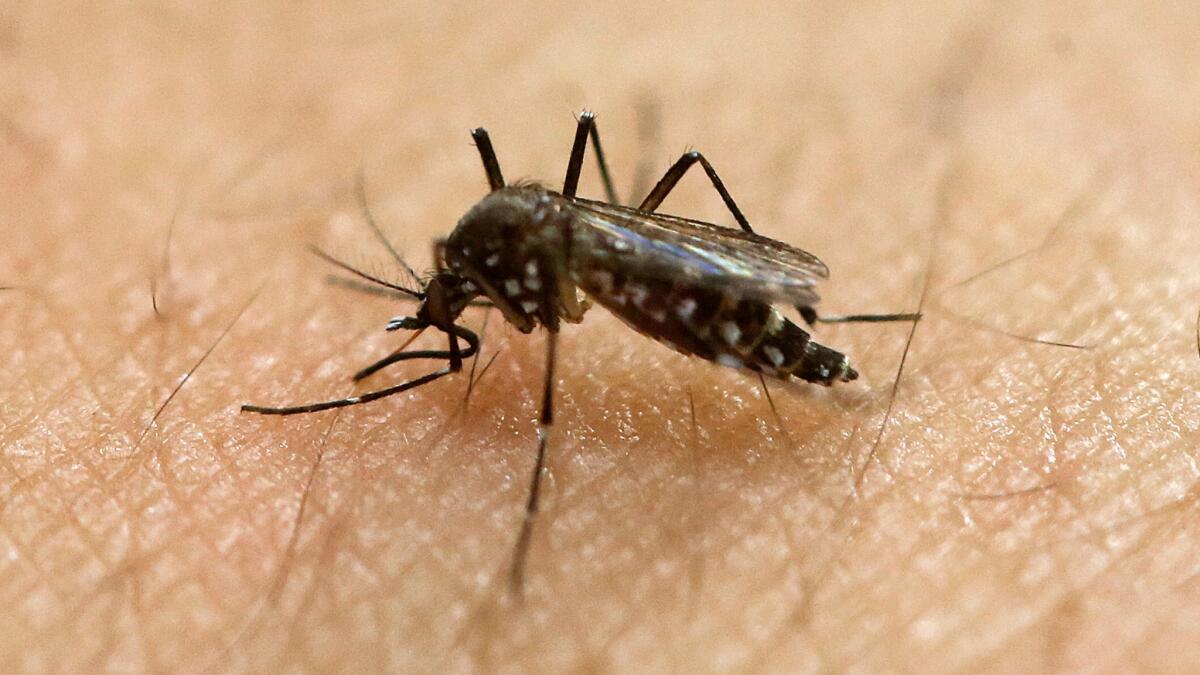Column: The latest threat to the Southern California dream: Mosquitoes

- Share via
My understanding, when I moved to Southern California nearly 20 years ago, was that in addition to perpetual sunshine, palm trees, movie stars and Mexican food, there would be no mosquitoes.
And for the first 15 years, there weren’t. We left the doors and windows open; we sat in the yard on warm summer nights. I was never bitten, not once.
But today, paradise is no more. The mosquitoes have arrived. And with them, a fundamental piece of the Southern California dream is going the way of Bullocks Wilshire, the Pacific Electric company’s Red Cars and, I don’t know... the Brown Derby. An Angeleno’s personal freedom to sit outdoors unmolested by bugs is under attack.
Seriously, this is a big deal.
On Aug. 24, 1915, this newspaper wrote: “One of the charms of Los Angeles which has not been referred to in any of the guidebooks or the Chamber of Commerce circulars or the real estate advertisements is the absence of mosquitoes. The winged swordsman of the summer is not, except in a few disfavored localities, to be found within this city.”
In July 1934, The Times said: “We have no mosquitoes in Southern California — or very darn few of them.”
On Aug. 24, 1989: “There are remarkably few mosquitoes in much of Los Angeles.”
Yeah, well, not anymore.
Now I know perfectly well that there have always been some mosquitoes here. Mosquito abatement programs date to the early days of the 20th century. There have been outbreaks of mosquito-borne diseases over the years.
But the biting was never like this.
What’s changed is the arrival of several new species. First came the Aedes albopictus in the early 2000s. More recently, Aedes aegypti and Aedes notoscriptus. They are more aggressive with people than the region’s traditional mosquitoes, they bite all day long and they like to hover around the ankles — but somehow by the time you’re aware you’ve been bitten, they’re gone, often to your other ankle. These nasty little buggers can lay their eggs in the tiniest bit of stagnant water, even in a space as small as a bottle cap, making them difficult to eradicate.
And they can carry some very serious diseases.
What’s more, they’re spreading geographically, and growing denser where they already exist, according to Susanne Kluh, director of scientific and technical services for the Greater Los Angeles County Vector Control District. Kluh says that complaints from horrified Angelenos and the agency’s own scientific measurements suggest the mosquito population has increased dramatically again this year.
This is a lifestyle nightmare. But it’s also a serious potential health risk.
Here’s the way a mosquito bites. She lands on your skin. (Yes, only female mosquitoes bite; they need the blood to produce their eggs.) She makes several piercings as she searches for a blood vessel with the tip of her needle-like proboscis. Then she digs in, sucking in the blood while injecting saliva that contains an anti-coagulant. If she is infected with a virus or other pathogen, it can be passed to you through her saliva.
Amazingly, although mosquito-borne malaria is thousands of years old, scientists were unaware until the late 19th century of the relationship between mosquitoes and disease. In fact the two are murderously co-dependent: Mosquitoes are harmless unless they have bitten an infected person (or, often, an infected bird). And the diseases can’t spread without the mosquitoes.
The World Health Organization says that diseases transmitted by mosquitoes are responsible for “several million deaths” each year.
One big concern in our region is West Nile disease. The Culex mosquitoes that have long been established in Southern California have been carrying that virus since it arrived in the area in 2003.
“West Nile is a pernicious disease that in its acute form can attack your brain and create delirium, hallucinations,” said Zev Yaroslavsky, the former Los Angeles County supervisor whose wife, Barbara, died of complications during treatment for the disease in December 2018. She had been bitten by mosquitoes in her Beverly-Fairfax neighborhood.
“Every one of those little insects is like a missile flying toward you,” said Yaroslavsky. “And you have no idea which one carries the atom bomb.”
Only about 1 in 5 people infected with West Nile develop any fever or symptoms, and many fewer than that become seriously ill, according to the Centers for Disease Control and Prevention.
The newly arrived Aedes mosquitoes have the ability to carry and spread dengue fever, Zika, chikungunya and others.
So far, there have been no known, locally acquired transmissions of those diseases in our area. But there have been in Texas and Florida.
Kluh says her vector control district has changed its program dramatically in response to the Aedes mosquitoes, including adding 15 new staff positions, creating an entire sub-program to deal with “daytime biting” complaints, retraining staffers to identify different breeding sources and disseminating information about Zika, dengue and other viruses. Advice for residents is available here: https://www.glacvcd.org
It’s easy to underestimate mosquitoes, which Microsoft co-founder and philanthropist Bill Gates calls “the deadliest animal in the world.” We may see them mostly as irritants to be swatted away, but history professor Timothy Winegard of Colorado Mesa University told me in a recent interview that “many pivotal events in history have been shaped by mosquito-borne pathogens,” including the rise of the Roman Empire, the retreat of Alexander the Great in India and the defeat of the Confederate Army.
And even if mosquitoes don’t end up reshaping the history of Southern California, they are already reshaping our way of life. If we have to hide at home all day from the coronavirus, shouldn’t we at least be able to sit outside without slapping at Aedes aegypti or drowning in bug spray?
More to Read
A cure for the common opinion
Get thought-provoking perspectives with our weekly newsletter.
You may occasionally receive promotional content from the Los Angeles Times.











